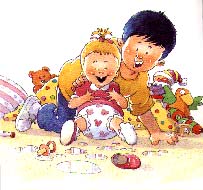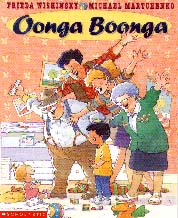|
________________
CM . . . .
Volume V Number 5 . . . . October 30, 1998
excerpt: Nobody could make Baby Louise stop crying. Her mother tried. She held her close and sang a little lullaby. But that didn't help. Louise kept on crying until her tears ran like rivers to the sea.  Because of the writing style and the Martchenko illustrations,
this book both reads and looks like a Robert Munsch book.
Wishinsky has utilized the abbreviated sentences, repetition and
hyperbole that have made Munsch books so popular with parents and
kids. This story, first published in 1990 and illustrated by
Sucie Stevenson, has been republished with the Martchenko
illustrations. It will be a certain hit with young children who
enjoy an exaggerated tale.
Because of the writing style and the Martchenko illustrations,
this book both reads and looks like a Robert Munsch book.
Wishinsky has utilized the abbreviated sentences, repetition and
hyperbole that have made Munsch books so popular with parents and
kids. This story, first published in 1990 and illustrated by
Sucie Stevenson, has been republished with the Martchenko
illustrations. It will be a certain hit with young children who
enjoy an exaggerated tale.
Baby Louise ignores all attempts to stop her crying and eventually upsets the whole neighbourhood as concerned adults offer advice and disgruntled animals flee with dismay. It isn't until her brother Daniel arrives home from school and says the magic words, "oonga boonga," that Baby Louise ceases sobbing and begins to smile again. Family members repeat the words, and little Louise grins from ear to ear. Once Daniel goes out to play, however, the words lose their appeal, and once again she is inconsolable. It is no surprise, then, that, upon his return, he quells her tears with the nonsense words, "bonka wonka." The energetic cartoon quality of Martchenko's illustrations suit this humorous tale of the special bond between a baby and her big brother. Louise's features are appropriately exaggerated. When she is squalling, she is mostly mouth with a rigid body, but, when smiling, her face and whole body relax. Young children, who know the world revolves around them, will have no trouble accepting that a baby can throw all the adults into a tizzy and only a young boy can restore harmony. Recommended. Alison Mews is the Coordinator of the Centre for Instructional Services at the Faculty of Education, Memorial University of Newfoundland.
To comment on this title or this review, send mail to cm@umanitoba.ca.
Copyright © the Manitoba Library Association.
Reproduction for personal use is permitted only if this copyright notice
is maintained. Any other reproduction is prohibited without
permission.
Published by
TABLE OF CONTENTS FOR THIS ISSUE - OCTOBER 30, 1998.
AUTHORS |
TITLES |
MEDIA REVIEWS |
PROFILES |
BACK ISSUES |
SEARCH |
CMARCHIVE |
HOME
|

